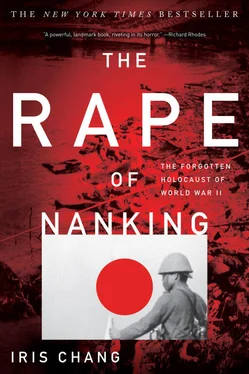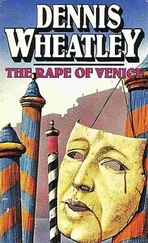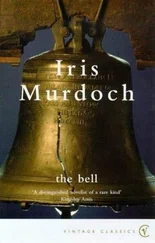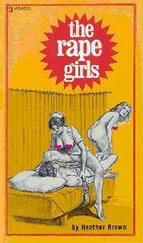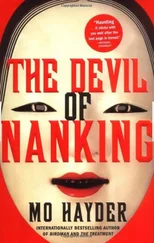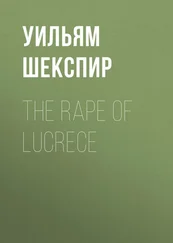What happened to Azuma Shiro, the first Japanese veteran to admit openly his crimes in Nanking, is a spectacular example of the system of Japanese intimidation at its worst. In 1987 he created a sensation when he became the first former Japanese soldier to apologize in public for his role in the Nanking massacre. On the eve of his departure to Nanking to participate in a fifty-year memorial ceremony of the great Rape, he gave interviews to newspaper and television reporters at a press conference in Kyoto. The result was an avalanche of criticism and death threats. To protect himself, Azuma retired from his company and moved with his wife into a house in a tiny village outside Kyoto, where he kept an arsenal of weapons, such as truncheons, clubs, pepper sprays, chains, and knuckle dusters.
The troubles for Motoshima Hitoshi, the mayor of Nagasaki, began when he was asked by a Communist Party member in the city assembly what he thought of the emperor’s wartime guilt. It was December 7, 1988, the forty-seventh anniversary of the attack on Pearl Harbor. Emperor Hirohito was slowly dying of cancer, and the nation was mourning the passing of the Showa era by muting the holiday festivities. Motoshima responded that, having read accounts of the war from abroad and served as a soldier himself, he believed that the emperor bore responsibility for the war. The response to his statement was immediate. The next day enraged city legislators and the local branch of the Liberal Democratic Party demanded that the mayor retract his words. But Motoshima refused, announcing that he could not “betray his own heart.”
His opponents then embarked on a violent campaign of harassment and intimidation calculated to bring the mayor to his knees. The Liberal Democrats not only dismissed him as the counsel to their organization but succeeded in convincing the prefectural governor to refuse to cooperate politically with the mayor. Right-wing groups even called for Motoshima’s death. On December 19, 1988, twenty-four ultranationalist groups drove through Nagasaki on thirty loudspeaker trucks, blasting their demands for “divine retribution” through Motoshima’s death. Two days later the number of groups demonstrating in Nagasaki had grown to sixty-two, and the number of loudspeaker trucks to eighty-two. Representatives from numerous conservative organizations, including the office for Shinto shrines, called for his impeachment. Less than two weeks after Hirohito’s death on January 7, 1989, a right-wing fanatic shot Motoshima in the back. The bullet punctured his lungs, but miraculously, the mayor survived. The assassination attempt thrilled extremists across the nation, many of whom proclaimed the deed as nothing less than “divine punishment.”
THE RAPE OF NANKING was only one incident in a long saga of Japanese barbarism during nine years of war. Before the great massacre, Japan had already earned notoriety as the first country in Asia to break the taboo and use airpower not only as a battlefield weapon but as a means of terrorizing civilian populations. Then it launched its armed forces on a campaign of slaughter that started in Shanghai, moved through Nanking, and proceeded inland.
While there was no Japanese equivalent of a “final solution” for the Chinese people, the imperial government endorsed policies that would wipe out everyone in certain regions in China. One of the deadliest was the “Three-all” policy (“Loot all, kill all, burn all”) in northern China, where Communist Chinese guerrillas had fought the Japanese furiously and effectively. In his diary, a frustrated Japanese colonel reveals the cruel simplicity of this policy: “I have received orders from my superior officer that every person in this place must be killed.”
The result was a massive terrorist campaign in 1941 designed to exterminate everyone in the northern Chinese countryside. It reduced the population there from 44 million to 25 million people. At least one author on China, Jules Archer, believes that the Japanese killed most of the 19 million people who disappeared from the region, though other scholars speculate that millions must have fled to safer ground. R. J. Rummel, author of China’s Bloody Century, points out that even if only 5 percent of the population loss consisted of murder victims, that would still amount to nearly 1 million Chinese.
The Japanese also waged ruthless experiments in biological warfare against the Chinese. Some of it was retaliatory and directed against Chinese villages suspected of helping American fliers during the April 1942 Doolittle raid of Tokyo. In areas that may have served as landing zones for the bombers, the Japanese massacred a quarter-million civilians and plowed up every Chinese airfield within an area of twenty thousand square miles. Here as well as elsewhere during the war, entire cities and regions were targeted for disease. We now know that Japanese aviators sprayed fleas carrying plague germs over metropolitan areas like Shanghai, Ningpo, and Changteh, and that flasks of disease-causing microbes—cholera, dysentery, typhoid, plague, anthrax, paratyphoid—were tossed into rivers, wells, reservoirs, and houses. The Japanese also mixed food with deadly germs to infect the Chinese civilian and military population. Cakes laced with typhoid were scattered around bivouac sites to entice hungry peasants; rolls syringed with typhoid and paratyphoid were given to thousands of Chinese prisoners of war before they were freed.
The final death count was almost incredible, between 1,578,000 and 6,325,000 people. R. J. Rummel gives a prudent estimate of 3,949,000 killed, of which all but 400,000 were civilians. But he points out that millions more perished from starvation and disease caused in large part by Japanese looting, bombing, and medical experimentation. If those deaths are added to the final count, then one can say that the Japanese killed more than 19 million Chinese people in its war against China.
It is impossible for most people to imagine exactly what went through the minds of Japanese soldiers and officers as they committed the atrocities. But many historians, eyewitnesses, survivors, and the perpetrators themselves have theorized about what drove the naked brutality of the Japanese imperial army.
Some Japanese scholars believe that the horrors of the Rape of Nanking and other outrages of the Sino-Japanese War were caused by a phenomenon called “the transfer of oppression.” According to Tanaka Yuki, author of Hidden Horrors: Japanese War Crimes in World War II, the modern Japanese army had great potential for brutality from the moment of its creation for two reasons: the arbitrary and cruel treatment that the military inflicted on its own officers and soldiers, and the hierarchical nature of Japanese society, in which status was dictated by proximity to the emperor. Before the invasion of Nanking, the Japanese military had subjected its own soldiers to endless humiliation. Japanese soldiers were forced to wash the underwear of officers or stand meekly while superiors slapped them until they streamed with blood. Using Orwellian language, the routine striking of Japanese soldiers, or bentatsu, was termed an “act of love” by the officers, and the violent discipline of the Japanese navy through tekken seisai, or “the iron fist,” was often called ai-no-muchi, or “whip of love.”
It has often been suggested that those with the least power are often the most sadistic if given the power of life and death over people even lower on the pecking order, and the rage engendered by this rigid pecking order was suddenly given an outlet when Japanese soldiers went abroad. In foreign lands or colonized territories, the Japanese soldiers—representatives of the emperor—enjoyed tremendous power among the subjects. In China even the lowliest Japanese private was considered superior to the most powerful and distinguished native, and it is easy to see how years of suppressed anger, hatred, and fear of authority could have erupted in uncontrollable violence at Nanking. The Japanese soldier had endured in silence whatever his superiors had chosen to deal out to him, and now the Chinese had to take whatever he chose to deal out to them.
Читать дальше
